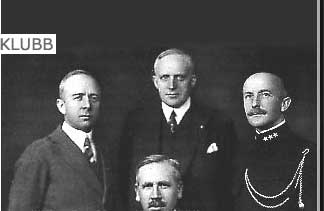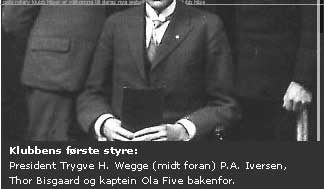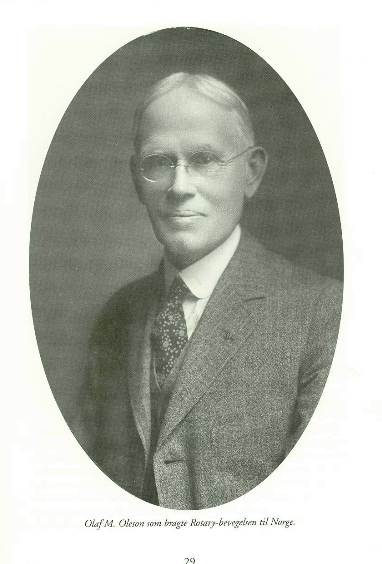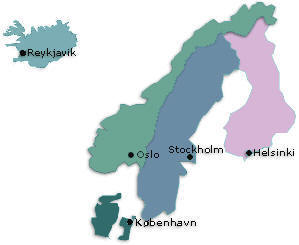

 Olaf
M Oleson took the initiative of forming the RC Oslo after contacting his
cousin Guardes Captain Ola Five who accepted the task. Olaf
M Oleson took the initiative of forming the RC Oslo after contacting his
cousin Guardes Captain Ola Five who accepted the task. |

OSLO ROTARY KLUBB -
The first and the largest Rotary Club in Scandinavia
It was the Norwegian-American US Senator Olaf M. Oleson who brought the
ideas of Rotary to Scandinavia in 1921. Oslo Rotary Club - then Kristiania
Rotary Club (the Capital of Norway changed its name to Oslo in 1924) - held
its inaugural meeting later that year, when the first members of the board
and the first president were elected.
Oslo Rotary Club was granted its Charter by Rotary International on June 1,
1922, and is consequently the oldest Rotary Club in Scandinavia. For the
last decades the number of members has been slightly above 200.
We welcome you warmly as our guest during your stay in Oslo. Where and when
we meet: We meet at the "Det Norske Teater" (The
Norwegian Theatre) Kristian IV's gate 8., every Thursday at
11.45 a.m.
Read about Paul Harris' visit to Oslo in 1932
The Father of Rotary in Norway
Records indicate that Ole Oleson of Fort Dodge, Iowa, and Harry Weer of Tacoma, Washington
worked with Oslo friends, Otto Hoff, Olaf Five (a cousin), P.A. Iverson and Thor Bisguard to organize
the Kristiania (Oslo) Rotary Club in 1922.
Weer had been in Rotary since
1914 and was Vice President of the West Coast Grocery Company though his connection with Oleson
and Norway is not clear.
Oleson was a charter member of Fort Dodge RC and he is credited with 100% attendance for over 25 years.
The only time he missed a meeting was when he was aboard ship on his way to Europe.
Even when he was in Europe after 1922 he is credited with attending meetings there.
Surprisingly he was never president of the local club or held office
at district level. On April 15, 1932, Oleson received a cable from
the Oslo Club on the occasion of its 10th anniversary, and it
recognized him as 'the father of Rotary in Norway'. In the following
years, the Fort Dodge Club had visitors from Norway on various
occasions, and on June 26, 1939, held a special meeting to celebrate
Oleson's involvement with Norwegian Rotary. But then came the war,
and on September 16, 1940, a Norwegian economist from Oslo, O. Gjergjo,
who had left Norway at the beginning of the War and had come to Iowa
State College, presented a program on conditions in Norway after the
Nazi invasion.
The connection between Fort Dodge, Iowa, and Kristiania (Oslo) is
interesting. Oleson was born June 29, 1849. One source says he
was born near Stenkjer, and another says Stod, Trondhjem, in Norway,
the son of a farmer and teacher. He completed his schooling in
Norway and then seems to have gone to a school for horticulture or was
employed as an apprentice in horticulture in Kristiania for two years.
Records show that Ole (Olaf) Oleson migrated from Norway to the USA in
1870. The family name seems to have been Five but he changed it
to Oleson when he came to the U.S. He went to join a brother in
Fort Dodge, Iowa where he worked on a farm and in a local pharmacy.
In 1873 he attended the Philadelphia College of Pharmacy
from which he graduated with honors. He was there during the
Philadelphia World's Fair at which he was exposed to the latest
technology which influenced him in his business career. He returned
to Fort Dodge to establish the Oleson Drug Company which was not only
a retail drug store but also a large drug distributor/wholesale house.
He was not just a pharmacist but also an entrepreneur and 'Renaissance
man', successful in all that he did. He was founder of the Fort
Dodge Light and Power Company drawing on his experiences at the
World's Fair. Likewise he founded the Fort Dodge Telephone
Company, the Fort Dodge Hotel Company and the Oleson Land Company.
The last led him to become one of the major developers in Fort Dodge
at the time of its greatest expansion. He also was a major investor
in most of the new businesses which began in Fort Dodge, including
Fort Dodge Labs for animal pharmaceuticals. He was also a highly
respected botanist. His plant collection is the basis for the
collection at Iowa State University and he wrote a manual in local
botany and native plants which was used on the college level. He
was the community's greatest philanthropist giving the city two parks,
contributing heavily to the establishment of the city's two hospital,
providing funds for the construction of a Congregational
Church. From 1891 to 1895 he served also as a Democrat State
Senator. Oleson was proud of his Norwegian heritage, returning
annually to Norway on visits during most of his life, rarely missing a
Rotary meeting there. He was an officer and treasurer of the
Norwegian American Historical Association and promoted Norwegian
culture and heritage in the United States, especially with his support
of Norwegian choral singing. He was a founder of the association
for Norwegian men's singing and never missed one of the associations
national song fests. He organized the Fort Dodge
Manskor and was its long time director. In 1928 he was knighted with
the Order of St. Olaf by King Haakon VII for his efforts in preserving
Norwegian heritage. Oleson died in 1944.
 In
1949 the sculptor Clifton Adams made a relief memorial to Oleson,
which now stands in a park presented to the city by Oleson. The
6 panels depict stages in his life. In
1949 the sculptor Clifton Adams made a relief memorial to Oleson,
which now stands in a park presented to the city by Oleson. The
6 panels depict stages in his life.
Click for larger image
This account is based on material provided by Roger Natte of Fort
Dodge to whom we are grateful for his research. Compiled by Basil Lewis.
January 2009 |





 Olaf
M Oleson took the initiative of forming the RC Oslo after contacting his
cousin Guardes Captain Ola Five who accepted the task.
Olaf
M Oleson took the initiative of forming the RC Oslo after contacting his
cousin Guardes Captain Ola Five who accepted the task.